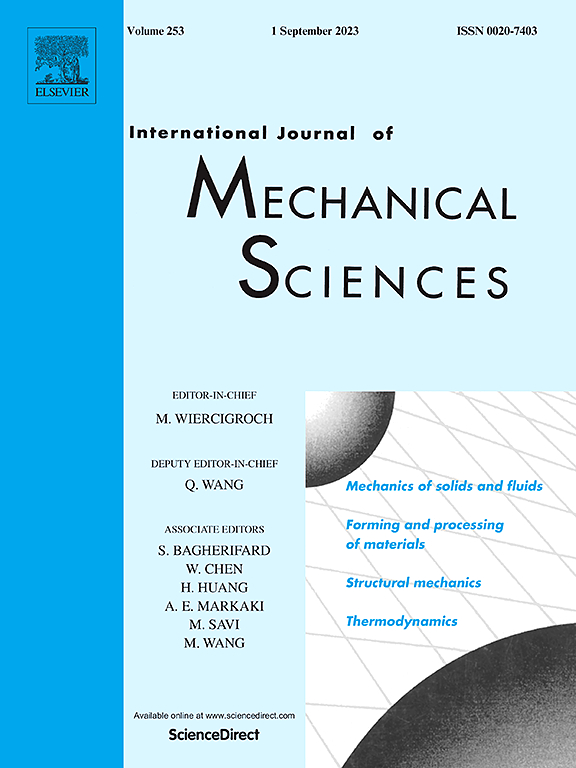分层结构钛合金的弹塑性和室温蠕变行为模拟
IF 7.1
1区 工程技术
Q1 ENGINEERING, MECHANICAL
International Journal of Mechanical Sciences
Pub Date : 2025-04-21
DOI:10.1016/j.ijmecsci.2025.110294
引用次数: 0
摘要
钛(Ti)合金具有优异的强度和抗蠕变性能,可通过显微组织和晶体取向进行有效控制。大多数作品和模型都集中在单阶方法、一个微观结构特征或现象学框架上。目前很少有基于变形机制驱动的理论模型能够整合分层微观结构的复合材料。在本工作中,测量了这些双相Ti合金的弹塑性和室温蠕变行为,并在实验中观察到双相Ti合金的分层结构:在细观上由软相和硬相组成,这是由于晶体取向的差异造成的;在微观上由等轴α相和次级(α+β)过渡相组成的复合结构。在细观力学的框架下,通过SEM的显微组织组成和EBSD的晶晶取向,以及相界上的位错堆积,建立了分层组织钛合金的弹塑性本构模型。此外,通过对Theta模型的修正,研究了具有分层结构的双相钛合金的室温蠕变本构模型,并考虑了蠕变稳态位错运动。理论结果表明,模拟的弹塑性曲线和蠕变本构曲线与实验测量结果吻合较好,包括屈服应力、应变硬化和稳态蠕变速率。利用所建立的本构模型进一步预测了不同晶粒尺寸和相体积分数双相钛合金的力学性能和蠕变特征:晶粒尺寸越大,软相体积分数越高,屈服强度越低,稳态蠕变速率越高;界面比越大,屈服强度越高,稳态蠕变速率越低。至关重要的是,提出的理论建模框架引入了一种新的方法来表征分层结构材料的力学行为。即基于实验观察和弹塑性力学的框架,通过微观力学理论和晶体位错理论建立描述材料力学性能的理论模型。这些发现和所建立的模型有助于通过设计复合材料的取向和组织分布来优化双相钛合金的屈服强度、应变硬化率和蠕变性能。本文章由计算机程序翻译,如有差异,请以英文原文为准。
Modelling elastoplastic and room-temperature creep behaviors in Titanium alloys with hierarchical structures
Titanium (Ti) alloys possess excellent performance on the strength and creep resistance, which can be effectively manipulated through microstructure and crystal orientations. Most works and models have focused on single-order approaches, one microstructural feature, or phenomenological frameworks. There are few deformation-mechanism-driven and theoretical models with integrate hierarchical microstructure composite. In this work, the elastoplastic and room-temperature creep behaviors are measured in these dual-phase Ti alloys, and the hierarchical structures are experimentally observed in the dual-phase Ti alloys: the first order of hierarchical structures consists of the soft phase and the hard phase attributed to differences in crystal orientation at mesoscale, and the second order is about the composite structure composed of the equiaxed α phase and the secondary (α+β) transition phase at the microscopic level. Within the framework of the micromechanics, the elastoplastic constitutive model for the hierarchically structured Ti alloys is developed through considering the microstructural compositions from SEM and the grain-crystallographic orientation from EBSD, as well as the dislocations pile-up along the phase boundaries. Furthermore, the room-temperature creep constitutive model is also addressed through modifying the Theta model and involving the creep steady-state dislocation motion for the dual-phase Ti alloys with hierarchical structures. Theoretical results demonstrate that the simulated elastoplastic curve and creep constitutive curves are agreeable well with experimental measurements, including the yield stress, strain hardening, and the steady-state creep rates under different applied stresses. The proposed constitutive models are further utilized to forecast the mechanical properties and the creep features of dual-phase Ti alloys with various grain size and volume fraction of phases: the larger grain size and the higher volume fraction of soft phase can lead to the lower yield strength and the higher steady-state creep rates, while the increased interfaces ratio results in the higher yield strength and the lower steady-state creep rates. Crucially, the proposed theoretical modeling framework introduces a novel methodology to characterize the mechanical behaviors of hierarchically structured materials. Namely, based on experimental observations and the framework of elastoplastic mechanics, a theoretical model describing the mechanical properties of materials is established through the micromechanical theory and the crystal dislocation theory. These findings and the proposed models could be helpful for optimizing the mechanical properties of dual-phase Ti alloys such as the yield strength, strain hardening rate, creep performance by designing the composites orientations and distributions of microstructures.
求助全文
通过发布文献求助,成功后即可免费获取论文全文。
去求助
来源期刊

International Journal of Mechanical Sciences
工程技术-工程:机械
CiteScore
12.80
自引率
17.80%
发文量
769
审稿时长
19 days
期刊介绍:
The International Journal of Mechanical Sciences (IJMS) serves as a global platform for the publication and dissemination of original research that contributes to a deeper scientific understanding of the fundamental disciplines within mechanical, civil, and material engineering.
The primary focus of IJMS is to showcase innovative and ground-breaking work that utilizes analytical and computational modeling techniques, such as Finite Element Method (FEM), Boundary Element Method (BEM), and mesh-free methods, among others. These modeling methods are applied to diverse fields including rigid-body mechanics (e.g., dynamics, vibration, stability), structural mechanics, metal forming, advanced materials (e.g., metals, composites, cellular, smart) behavior and applications, impact mechanics, strain localization, and other nonlinear effects (e.g., large deflections, plasticity, fracture).
Additionally, IJMS covers the realms of fluid mechanics (both external and internal flows), tribology, thermodynamics, and materials processing. These subjects collectively form the core of the journal's content.
In summary, IJMS provides a prestigious platform for researchers to present their original contributions, shedding light on analytical and computational modeling methods in various areas of mechanical engineering, as well as exploring the behavior and application of advanced materials, fluid mechanics, thermodynamics, and materials processing.
 求助内容:
求助内容: 应助结果提醒方式:
应助结果提醒方式:


